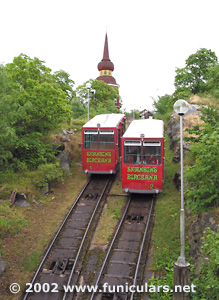|
s
How a funicular works

Two cars meeting on a passing track. Funicular at Skansen.
|
The funicular
A funicular conquers the problem of steep slopes very elegantly, by combining ordinary lift (elevator) technology with railway technology: the lift that's pulled up and down by a cable, and the railway where a car goes back and forth on rails.
The motorless car, then, is pulled up the incline by a cable, making the lack of friction between wheel and rail irrelevant. The wheels contribute no pulling power at all; they simply guide the car up the incline on the rails.
Counterweights
But the really clever aspect of a funicular is that it uses two cars at once, connected to each other by the cable, which passes through a large wheel at the upper station. In this way, the two cars serve as counterweights to each other. When the car at the top goes down, the car at the bottom goes up at the same time.
A motor is still needed to pull the cable, but it only needs to overcome the difference in weight between the cars, which is the weight of the passengers, and the friction inherent in the system. The motor is permanently installed in the upper station, and transfers its power to the driving wheel through which the cable runs.
 previous page - contents - next page previous page - contents - next page 
© Text och photo: Bruse LF Persson
|